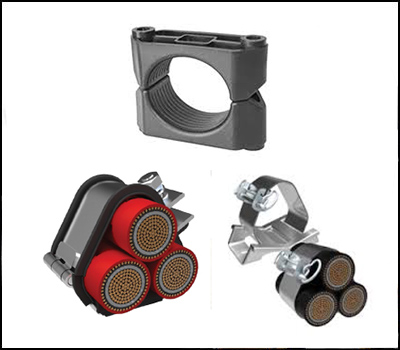One of the major investments done by the leading electronic company, manufacturing unit and OEM’s in all the dominant sectors is considerably seen especially in the application of HV cable tunnels. Substantially, this gave a decent rise to the investments in new HV cable installation. The traditional 275KV & 400KV fluid filled HV cable circuit needed a transformation in its circuit design. So a modification in the HV cable system was brought to implementation with the use of high voltage single core cable system that needed strong, tough and highly durable cable cleats to provide a well-grounded support to the cables at the particular interval. This article is a precise content on the best suited cable cleats that are used in the HV cable system. The article also uncovers the gravity and riches of the cable cleats for supporting and clamping of the HV cable system especially in the underground cable tunnels.
The percentage of people dwelling in the major cities of UK and US shows an upward slope in the growth map. Also the development and rise in the industrial setups, heavy machineries, underground electrical projects, tunnels and other high voltage mechatronics has become core concentration for the researchers. All these indirectly rely on the electric power supply and distribution which is becoming one of the critical affairs to make it function smoothly with highly secured cabling system. With this, the HV cable tunnels are gradually becoming a preferred choice as they help support the non-intrusive installation and functioning to carry the high voltage cables. On a severe note, it is vital to know about the issues addressed with the clamping and supporting of HV cable system in the underground cable tunnels and what are the apt solutions for the same.
How the use of Cable Cleat saves the HV cables from explosion or damage when installed in underground tunnels?
The HV single core cable is structured in a flexible vertical arrangement in the cabling system. The support that the cable needs is given by the cable cleats that are installed in particular distance or interval decided in the planning stage which is generally kept between 5 & 8.5 metres allowing the cables to sag in between. The HV cables being allowed to sag in between the support point gives room for the cable to control the contraction and expansion in steady manner that restricts the thermo-mechanical forces to exert in large scale. Also at the time of load cycles, the sheath and cable conductors develop thermo mechanical thrust in an axial direction that requires to be constrained by the Cable Cleats that also takes a due care to avoid damage to the cable over sheath.
Furthermore, during the lightning conditions and short circuit faults that result in the flow of high fault currents through the cables will end up with large electro mechanical forces among the cores. This immediately damages the cable violently. This makes the cable to experience an accelerated sidewall pressure at the fixing points that can disturb and damage the whole HV cable system at large. One of the significant pieces of equipment that can help to overcome such type of issues is the Cable Cleat being the chief component of the fault protection system.
Bringing constant improvement and modification in the cable cleats made the HV power cable installation a common place with bringing a varied range of HV cable cleats in the market that provided a trusted, tested and tried solutions ensuring the high voltage cables are stable, working and intact during short circuit conditions.
The manufacturing process of the cable cleats also showed great transformation with technology up gradation every other day. The development in design of cable straps & saddles and the efficiency in the short circuit testing become a focal point to bring modification in cable cleats from the very base. Let’s see how!
The lists of basic rules to be followed become the name of the game for coming up with accurate modifications in the cable saddle. The cable saddle should be able to bear the weight of the cables without changing or deflecting its original profile. The cable saddle design should also match up with that of the cable sag radius for a particular installation. One important thing to note is the cable should not come in contact with the sharp edges of the cable cleats. An additional flare should be added to the cable as it leaves the saddle and should be placed on each end point of the curved cable saddle. This helped reduced the possibility of the cables to come in contact with the sharp edged portion of the cable cleats. After these general rules are brought into implementation, the accurate calculation of the cleat spacing and installation is possible with ease and zero defects.
BICC Components Limited (BICC) is an experienced manufacturer and distributor of the cable cleats. Having a varied customer base and a skilled team of experts, we are able to offer varied types of Low voltage and High voltage Cable Cleats. Our manufacturing unit, well equipped tool room and strict testing modules have made it possible to provide quality and customization for high performance cable cleat manufacturing. To get more details on a range of cable cleats, visit https://www.bicccomponents.uk.com/bicc-cable-cleats/ . You can touch base with us at https://www.bicccomponents.uk.com/contact/
 SUBSCRIBE TO OUR BLOG
SUBSCRIBE TO OUR BLOG
